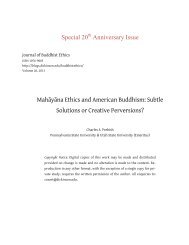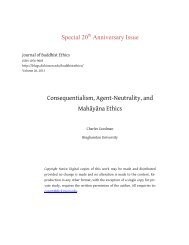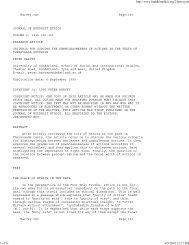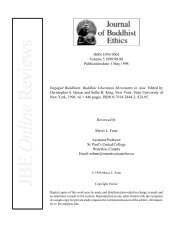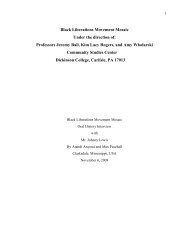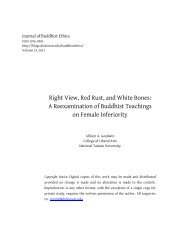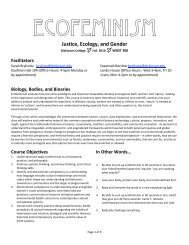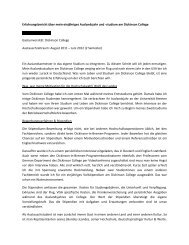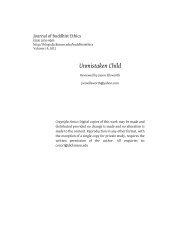Epstein, Dreams of Subversion INTRO ... - Dickinson Blogs
Epstein, Dreams of Subversion INTRO ... - Dickinson Blogs
Epstein, Dreams of Subversion INTRO ... - Dickinson Blogs
Create successful ePaper yourself
Turn your PDF publications into a flip-book with our unique Google optimized e-Paper software.
XVI Preface<br />
this work grew and developed, David challenged and encouraged me to tighten<br />
it, to ground it, to make it fit together as an integral study. For his patience, in<br />
particular, I am truly grateful.<br />
Pr<strong>of</strong>essor Walter Cahn <strong>of</strong> Yale is a consummate and masterly art historian,<br />
keenly discerning and observant <strong>of</strong> both the microcosmic and macrocosmic dimensions<br />
<strong>of</strong> iconography. By simultaneously warning me against overinterpretation<br />
and urging me to explore issues <strong>of</strong> national consciousness through art, he<br />
urged me toward the golden mean that transforms art into a truly useful tool for<br />
understanding the internal landscape <strong>of</strong> those who produced it.<br />
John Boswell was a friend and adviser in the truest sense <strong>of</strong> the word, even in<br />
the throes <strong>of</strong> the terrible illness that eventually took his life. He was a superlative<br />
editor, an ever-tactful critic, but most <strong>of</strong> all, a teacher. I learned and grew from<br />
every suggestion he made to me. His keen interest in issues and methodologies<br />
that cross disciplines and extend beyond the bounds <strong>of</strong> the mainstream and the<br />
expected, as well as his grace, wit, scholarly acumen, and philological integrity<br />
proved a constant inspiration.<br />
I was privileged to spend a wonderful year doing research at the Hebrew University<br />
in Jerusalem in 1988-89, where I received the assistance and counsel <strong>of</strong> a<br />
number <strong>of</strong> exceptional scholars in the fields <strong>of</strong> Jewish history and history <strong>of</strong> art. I<br />
am deeply grateful to Richard Cohen, who was the first to examine my proposal;<br />
I could not have picked a wiser or more incisive critic. Likewise, Reuven Bonfil<br />
has enriched this work by urging me to ask <strong>of</strong> the material what he calls "the<br />
questions which really matter." Avraham Grossman pored cheerfully and everaccommodatingly<br />
with me over halakhic materials and literary sources alike,<br />
most notably the torturous language <strong>of</strong> Yehudah Hadassi. Bezalel Narkiss<br />
and Elisheva Revel-Neher each took an active interest in this project in the early<br />
stages, and their suggestions with regard to matters iconographic have proved<br />
invaluable. Israel TaShema and Moshe Idel are two <strong>of</strong> a kind -fonts <strong>of</strong> information<br />
and helpful suggestion-both in terms <strong>of</strong> content and methodology. I learned<br />
more in a single bus ride with Idel about dogs, hares, and gilgul than I warrant I<br />
ever shall again (at least in this incarnation). The secrets revealed to me in the<br />
realm <strong>of</strong> libraries, manuscripts, and variant readings over c<strong>of</strong>fee with TaShema<br />
proved invaluable.<br />
Many individuals have been extremely helpful in reviewing various stages <strong>of</strong><br />
my finished manuscript and ideas and in providing guidance and encouragement.<br />
I am particularly indebted to Daniel Sperber, Nomi Feuchtwanger and<br />
Bracha Yaniv <strong>of</strong> Bar Han University, Elliot Horowitz <strong>of</strong> Ben Gurion University,<br />
Shalom Sabar <strong>of</strong> Hebrew University, and to John Ahern, Judith Goldstein, James<br />
Mundy, and Benjamin Kohl at Vassar.<br />
Dean Nancy Dye <strong>of</strong> Vassar, now president <strong>of</strong> Oberlin College, followed this<br />
research with particular interest and acuity. I have, over the years, maintained a<br />
lively exchange with Ivan Marcus at Yale about the relevance <strong>of</strong> this sort <strong>of</strong> work<br />
Preface XVll<br />
for the new Ashkenazic cultural studies, and Ruth Mellink<strong>of</strong>f and I have initiated<br />
a spirited e-mail correspondence on some <strong>of</strong> the issues dealt with herein. To Bill<br />
and Lisa Gross, collectors, scholars, humanitarians in the deepest sense <strong>of</strong> the<br />
word, go my sincerest gratitude for their warmth and interest.<br />
Finally, my colleagues at Vassar, Deborah Moore, Larry Mamiya, BetsyAmaru,<br />
Mark Cladis, Mary McGee, Lynn LiDonnici, Tova Weitzman-Leibovitch, and<br />
Eric Huberman, as well as the members <strong>of</strong> the Jewish Faculty discussion group,<br />
have supported this research in innumerable ways, intellectually as well as<br />
emotionally.<br />
Other wonderful supporters and friends have aided me in bringing my ideas<br />
before the public in various contexts. I am grateful to Myron Gubitz for giving<br />
some <strong>of</strong> my initial forays into this topic their first public airing in Grim, and<br />
Hananiyah Goodman for inviting me to participate in the series "Another World:<br />
Jewish Mysticism" at Yale. Nancy Troy at Art Bulletin was gracious in her desire<br />
to introduce my materials and methods to the wider world <strong>of</strong> art-historical scholarship.<br />
To David Roskies I am grateful for publishing an article that was a preliminary<br />
foray into the literary aspects <strong>of</strong> some <strong>of</strong> the arguments elaborated in<br />
this book. Laurie Patton has been a wonderful friend and editor, believing in my<br />
material, questioning my assumptions in a cross-cultural context, and ultimately<br />
anthologizing, in slightly different form, a section from this work. Vivian Mann<br />
provided extraordinary support, and invited me to present my conclusions on the<br />
iconography <strong>of</strong> the hare hunt as the Zucker Lecture in Jewish Art at the Jewish<br />
Museum in spring 1995. Elliot Wolfson <strong>of</strong> New York University and David Berger<br />
<strong>of</strong> Brooklyn College have followed my work with flattering interest, adding to it<br />
their patient guidance and acute suggestions. Guy Haskell <strong>of</strong> Emory and Shimon<br />
Brand <strong>of</strong> Oberlin have been the truest <strong>of</strong> supporters, above and beyond the call <strong>of</strong><br />
duty. Finally, I thank Michael Camille and Tony Perry for reading my manuscript,<br />
and Philip Winsor and Cherene Holland <strong>of</strong> the Penn State Press for being exceedingly<br />
supportive from the inception <strong>of</strong> this project to its completion. Barbara<br />
Cohen prepared the superb index and Caroline Kiel assisted with pro<strong>of</strong>reading.<br />
I gratefully acknowledge the support, financial and moral, tendered me by the<br />
following grants and foundations and the exceptional individuals associated with<br />
each. Without their help this book would literally not have been possible: the<br />
Andrew Mellon Foundation, from which I received the Fellowship in the Humanities<br />
(1985-88) that made it possible for me to attend Yale, and the Dissertation<br />
Year Fellowship (1990-91) that made it possible for me to begin this work.<br />
To the foundation, and its former director, Dr. Robert Goheen, I am exceedingly<br />
grateful. During 1990-91 I also received a John F. Enders Fellowship from Yale<br />
University, which made it possible for me to spend the summer months engaged<br />
in final adjustments to the project. Because <strong>of</strong> the exemplary support provided by<br />
these two grants, when I was <strong>of</strong>fered a grant from the National Foundation for<br />
Jewish Culture, in the same year, I accepted honorary status. I am equally thank-



